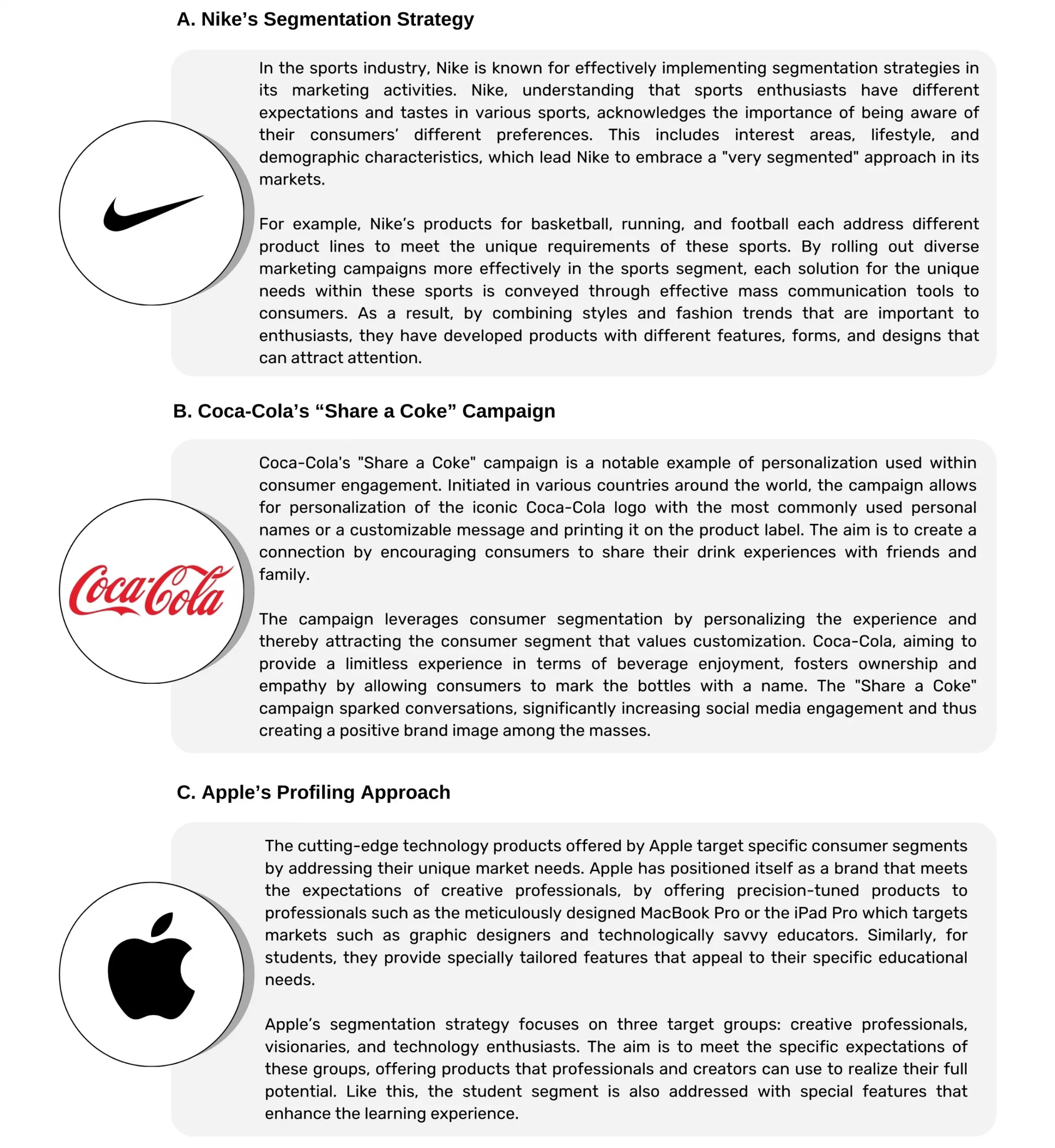
Perhaps one of the most important outcomes of segmentation is target audience segmentation. Segmentation helps businesses to analyze consumer behaviors more closely and identify groups sharing these behaviors. In this way, businesses can understand which groups are potential customers better and market more effectively by offering products and services adjusted to these groups. Deciding the target audience enables businesses to use their resources more wisely, create more focused marketing strategies, and ultimately be more successful.
What is a Target Audience?
The target audience definition is the group or demographic of people that form the focus of a specific marketing or communication strategy for a product, service, or message. The target audience is used to define and understand people with specific characteristics for the best presentation, promotion, and sale of a product or service. These characteristics may include age, gender, income level, interests, demographic data, and behavioral traits. Determining the target audience helps in designing effective marketing strategies and ensuring that the product or service reaches the desired customer group.How is the Target Audience Determined with Segmentation?
The segmentation process defines smaller, manageable parts of a broad and diverse market by identifying subgroups with similar characteristics. From these subgroups, the selection of the target audience, which can best utilize or access the company’s specific products or services, is made. This selection is based on considering the needs, desires, behaviors, and potential of the segments. Therefore, segmentation is a fundamental step in determining the target audience.
Segmentation in Marketing: Strategy Determination and Precision Targeting
Knowing, understanding, and effectively reaching the customers within your target audience is perhaps the most important indicator of commercial success. By segmenting a heterogeneous market based on customers’ common characteristics, needs, or behaviors, businesses can develop result-producing strategies to reach them, tailor their messages according to specific customer groups, and maximize marketing impacts on their target audiences.
Marketing segmentation refers to the process of dividing a broad and heterogeneous market into smaller, more manageable parts that share similar characteristics, interests, or behaviors.
For a long time, segmentation practices in marketing have differentiated customers based on their demographic characteristics, psychographic types, behavior patterns, or geographic locations. The ultimate goal of segmentation is to identify and understand the unique needs and preferences of different customer groups to provide a personalized and goal-oriented marketing experience through target audience segmentation.
The importance of target audience segmentation in creating a marketing strategy is undeniable. In today’s “information-overloaded” world and an era of continuously rising consumer expectations, expecting a single approach that fits ‘all customers’ to be effective is not feasible under current conditions. From this perspective, target audience segmentation offers businesses the opportunity to concretize and manage marketing activities by creating specific strategies for each particular customer group they focus on.
Let's briefly explain why segmentation is vitally important for the success of marketing activities:
Firstly, segmentation allows businesses to carefully identify and target well-defined, specific customer audiences. Marketers tailor all marketing messages, products, and campaigns to impact the target audiences by identifying each segment's unique characteristics and preferences.
This personalized target audience segmentation approach not only builds deeper relationships with customers but also increases the likelihood of converting potential customers into loyal ones.

Another point is that businesses can optimize marketing resources by focusing all activities on well-defined target audience segmentation groups. This approach has the potential to increase overall efficiency in businesses. Marketing segmentation allows companies to concentrate their resources on efficient target groups with the highest potential instead of spreading marketing messages weakly and infrequently across a broad market. This targeted approach leads to more successful marketing outcomes, higher conversion rates, and Return On Investment (ROI).
Another aspect to consider regarding the importance of segmentation for businesses is understanding the special needs and preferences of different customer segments and offering tailored solutions and experiences, which leads to increased customer satisfaction levels. When customers feel understood and cared for, they remain more loyal to the brand, are more likely to recommend it to others, and provide meaningful feedback for the company’s continuous improvement.
Furthermore, an effective segmentation strategy enables companies to allocate their resources efficiently by focusing on the segments with the highest revenue-generating potential. Marketers can develop targeted strategies that maximize sales and profitability by understanding the unique requirements and behaviors of different segments. This focused approach minimizes wasteful spending on irrelevant audiences, resulting in higher returns on marketing investments.

The Benefits of Segmentation in Marketing
Segmentation in marketing offers numerous benefits for businesses aiming to optimize their marketing activities and achieve meaningful results. Here are some of the key advantages that segmentation brings to marketing strategies:
A. Enhanced Targeting and Personalization
Advanced targeting and personalization allow businesses to focus on specific target audience groups and customize their marketing strategies accordingly. This process is closely related to aspects such as types of target audiences and the creation of target audiences. Marketers focus on specific target audience groups by segmenting the market and identifying these groups as different segments. In the target audience identification phase, criteria such as customer behaviors, demographic characteristics, and interests are used.
This segmentation enables businesses to tailor their messages and marketing communications specifically for each target audience group. Products and promotions are adapted to suit target audience groups appropriately. This personalized approach not only creates a deeper connection with customers but also increases the likelihood of converting potential customers into loyal ones. Offering content and deals specific to target audience groups attracts customers’ attention and better meets their needs.
Businesses can develop long-term customer relationships based on trust and satisfaction through this customized and target audience-focused approach. Processes for creating target audience types and target audiences enhance the effectiveness and efficiency of businesses’ marketing strategies while increasing their capacity to offer unique experiences to customers. As a result, Advanced Targeting and Personalization provide businesses with a competitive advantage by enabling them to better meet the needs of their customers and bind them to their brands.
B. Increased Marketing Efficiency
Marketing segmentation enables businesses to optimize their marketing resources and increase overall efficiency. Instead of adopting a broad, one-size-fits-all marketing approach, segmentation allows companies to concentrate their resources on customer groups with the highest potential. By focusing on well-defined segments, marketers can develop strategies that specifically address the needs, preferences, and problems of each segment. This targeted approach results in more successful marketing outcomes, higher conversion rates, and return on investment (ROI). Through segmentation, businesses can allocate their marketing budgets more efficiently and direct resources to where they are most likely to achieve results.
C. Increased Customer Satisfaction
Segmentation allows businesses to understand the special needs and preferences of different customer segments. Companies can increase overall satisfaction levels by creating personalized solutions, offering customized experiences, and communicating with personalized messages. Marketing segmentation enhances customer loyalty and elevates customers up the customer loyalty pyramid, increasing the number of brand advocates. Segmentation enables businesses to develop products, services, and marketing communications that are compatible with the unique expectations and desires of each customer segment, ultimately resulting in higher customer satisfaction and loyalty.
D. Higher Return on Investment and Profitability
Effective segmentation enables companies to classify their target audience and focus their resources efficiently on the segments with the highest revenue-generating potential. Marketers can develop targeted strategies that maximize sales and profitability by understanding the unique needs, behaviors, and purchasing patterns of different target audience segments. By tailoring their offers and marketing activities to specific segments, businesses can minimize the effort wasted on irrelevant audiences. This targeted approach ensures that marketing investments are directed towards activities with the highest likelihood of yielding a return. As a result, target audience segmentation contributes to achieving a higher return on marketing investments and enhances profitability.
E. Market Differentiation and Competitive Advantage

Segmentation allows businesses to identify their unique market segments and develop strategies that differentiate them from competitors. By understanding the different needs and preferences of specific customer groups, companies can offer specialized products, services, or experiences that more effectively cater to these segments. This differentiation positions the business as the preferred option for a particular niche segment, creating a competitive advantage.
Businesses can create a strong brand identity and develop customer loyalty programs by customizing their marketing messages and offers to the unique characteristics of each segment, preventing competitors from entering their markets.
As seen above, important concepts in marketing, such as target audience classification, target audience segmentation, creation of a target audience, and types of target audiences, significantly impact businesses’ strategic planning. By adopting these approaches, businesses can segment the market into more meaningful parts and direct their marketing resources more effectively. Additionally, by developing customized targeting and personalization-focused marketing strategies, businesses can enhance customer satisfaction..
Adopting strategies such as target audience segmentation, creation of a target audience, and types of target audiences allows businesses to analyze customer behaviors more deeply, create appropriate strategies, and ultimately achieve higher conversion rates and profitability. Approaches like target audience segmentation, creation of a target audience, and types of target audiences in modern marketing strategies provide businesses with a competitive advantage, helping them conduct more personalized and effective marketing efforts.
Segmentation Strategies and Approaches
A. Mass (Undifferentiated) Marketing
Known also as undifferentiated marketing or mass segmentation, this strategy treats the entire market as a homogeneous group. It assumes all customers have similar needs and preferences and, therefore, targets the whole market with a single marketing mix. Mass marketing is typically used for products or services with mass appeal or in markets where customer preferences do not significantly vary. While mass marketing can reach a wide audience, it lacks the personalization and customization that many consumers seek today.
B. Differentiated Marketing
Also known as multi-segment marketing, the differentiated marketing strategy focuses on targeting multiple distinct segments with specific marketing practices. Each segment is considered unique, and specific marketing mixes are developed to address the needs, preferences, and issues of each segment. Differentiated marketing recognizes the diversity of the market as a default and aims to create customized experiences for different segments. Comprehensive market research is required to implement this approach successfully. Differentiated marketing enhances customer satisfaction by offering solutions tailored to specific segments, leading to increased market share.
C. Concentrated Marketing
Also known as niche marketing or focusing on a single segment, concentrated marketing involves concentrating on a single, well-defined market segment. Businesses adopting this strategic approach identify an under-served niche market with specific needs or preferences. By dedicating their resources to this niche segment, businesses establish themselves as “experts” in that area, securing a strong position. Concentrated marketing allows for targeted marketing activities, customization of every kind of product proposition and content, and personalized experiences. However, businesses choosing this approach must carefully assess the potential risks and limitations of linking their revenue and growth to a single segment.
D. Micro Marketing
Micro marketing takes segmentation to an extremely detailed level by targeting individual customers or very small segments. This strategy utilizes advanced data analytics, automation technology, and customer insights to develop personalized marketing activities. Micro marketing often involves techniques such as one-to-one marketing, personalization, and location-based marketing to tailor products, messages, and experiences on an individual level. While micro marketing creates the highest level of personalization and individual relationship opportunities, it requires advanced data processing capabilities and careful consideration of customer privacy and ethical implications.
It’s beneficial to note that businesses can use a combination of these segmentation strategies based on their goals, industry dynamics, and target market characteristics. The choice of strategy typically depends on factors like the market’s heterogeneity level, resource allocation necessary for this area, competitive conditions, and customer expectations. Additionally, the business’s strategic roadmap depends on which segmentation method or methods they can utilize.
The successful implementation of segmentation strategies and approaches requires a comprehensive understanding of the target market, effective data collection and analysis, and continuous monitoring and adjustment. Businesses can optimize their marketing activities, enhance customer satisfaction, and achieve commercial success in a highly competitive market by selecting and applying the most appropriate segmentation strategy and approach.
Challenges and Considerations in Segmentation
While segmentation offers numerous benefits to businesses, it also presents challenges and issues that need careful consideration during its implementation. Marketers must carefully monitor the outcomes of segmentation efforts and assess the factors contributing to success. They may even conduct A/B tests to determine the most suitable segmentation strategy for their businesses.
Below are some common challenges and important points to consider when applying segmentation strategies:
A. Data Quality and Availability
Segmentation relies on accurate and reliable data. High-quality data are essential, yet often challenging to obtain. Businesses may have to work with incomplete or outdated data during segmentation processes. Concerns about data privacy or difficulties accessing relevant data sources are also common. Investing in data collection and ensuring data accuracy are critical for meaningful insights in segmentation. Integrating quantitative and qualitative data is another necessity.
To overcome this challenge, businesses need to use data collection methods that provide high-quality data and regularly validate and update their data sources. Investing in a central CRM system that enables segmentation and consolidates and unifies all customer data from various external sources (ERP applications, different customer databases, spreadsheets, web pages, membership forms, Customer Service Management systems, mobile applications, etc.) directly affects the quality of data used in segmentation.
It’s essential to remember that only with accurate, reliable, current, and clean data can analytical marketers make informed decisions about segment characteristics and develop effective marketing strategies.
B. Overlapping Segments and Complexity
In some cases, segments may display overlapping characteristics or behaviors, complicating the clear differentiation of segment definitions. This overlap makes it difficult to develop distinct marketing approaches for each segment. Analyzing segment boundaries carefully and focusing on the distinguishing features of each segment to target them as clearly as possible often requires significant R&D activity. Additionally, managing multiple segments simultaneously and developing strategies specific to each segment can complicate marketing operations
To narrow down the intersection set and conduct in-depth research and analyses with enriched real-time data, a CRM system with strong filtering and reporting features and advanced analytical functions is needed.
Furthermore, the complexity created by developing and implementing marketing applications specific to each segment can only be solved with a CRM software that has user-friendly marketing automation functions.
C. Excessive Segmentation
Finding the right balance between excessive segmentation and insufficient segmentation is another critical challenge in segmentation. Excessive segmentation occurs when a market is divided into too many small, narrowly defined segments, making it difficult to develop a strategy and allocate resources effectively. On the other hand, insufficient segmentation results in overly broad, mass segments that ignore significant differences among market customers.
Achieving the optimal level of segmentation requires careful analysis that considers both the heterogeneity of the market and the practicality of addressing different segments with specific marketing applications.
For such analyses, the reporting infrastructure of your CRM system should be user-friendly and capable of facilitating in-depth analyses easily without the need for specialized technical knowledge.
C. Changing Market Dynamics
We live in the age of speed. Market dynamics, including changes in consumer preferences, technological advancements, or emerging trends, directly affect existing segment definitions and transitions between segments. Segmentation practices must be managed with real agility and adapted to changing market conditions immediately. Regular monitoring of market trends, customer reactions and feedback, competitors’ activities, and continuous fine-tuning of segmentation strategies are necessary.
The dynamic nature of today’s markets and continuously changing consumer preferences create significant challenges for segmentation practices. Consumer behaviors change constantly due to influences such as technological advancements, cultural shifts, experiences, or new competitors entering the market. Marketers need to adapt their segmentation strategies to changing market dynamics and maintain sensitivity to change.
For this, the CRM system used must dynamically accommodate continuously refreshed and evolved segmentation experiences with data from all sources, yet without losing data consistency. The flexibility of the CRM system used and its ability to adapt without the need for technical knowledge is a critical factor in keeping up with this speed.
D. Budget and Resource Allocation
Segmentation is an area that requires significant investment in terms of time, budget, and expertise. Collecting, analyzing, and managing data, conducting market research, and developing customized marketing applications require a thoughtful resource management policy. Businesses must carefully consider the cost-effectiveness of segmentation in relation to expected returns. Balancing segmentation efforts with available resources is important for maintaining the sustainability of segmentation applications and ensuring alignment with overall business goals.
Marketing segmentation aims to offer customized experiences to target customer groups. However, every customization has a cost. Developing separate marketing strategies, product variations, and communication messages for each segment may require more resources (time, money, and expertise) than anticipated. Marketers need to balance customization with cost-effectiveness by assessing the potential return on investment (ROI) of segment-specific strategies and considering the practicality of each application.
Therefore, businesses can optimize resource management and ensure the alignment of customization efforts with expected benefits by leveraging CRM technologies with advanced automation functions and manageable processes that are scalable.
E. Integration of Marketing Activities
Segmentation should not be treated as an isolated activity but easily integrated into broader marketing activities. The segmentation strategy must be consistent with overall marketing objectives and complement other marketing activities. Ensuring that the marketing mix, including product development, pricing, distribution, and promotion activities, aligns with the needs and preferences of target segments is a fundamental principle of marketing. Integration among marketing activities enhances the customer experience and maximizes the impact of segmentation on overall marketing effectiveness.
To achieve this, an integrated network of marketing and sales activities fed by segmentation should be conceptualized. This setup can only be realized with a CRM system capable of managing all activities as projects and enabling coordination.
F. Legal and Ethical Issues Regarding Segmentation
Especially in B2C industry sectors, segmentation involves analyzing and categorizing customers based on various attributes and behaviors. Collecting customer data ethically, evaluating it responsibly, and respecting legal and moral principles regarding information security and personal data protection are crucial for corporate reputation. Businesses must be transparent and clear about their data collection practices, provide customers with the option to opt-in or opt-out at any time, and use customer data responsibly. Integrating ethical and legal compliance conditions into segmentation processes is essential for building trust and maintaining positive customer relationships.
Compliance with national and international information security standards, such as the GDPR (The General Data Protection Regulation) in European Union countries, the CCPA (California Consumer Privacy Act) in the USA, and local regulations like the Personal Data Protection Law (KVKK) in Turkey, is mandatory for segmentation efforts.
For this purpose, the CRM system used must adhere to national and international information security standards and strictly comply with all regulations and requirements.
Data is today’s most valuable asset. Therefore, customer data should be considered the most precious asset of a business.
G. Evaluation and Monitoring
Segmentation strategies must be continuously monitored and evaluated to make necessary adjustments. Regularly reviewing key performance indicators, market trends, and customer feedback helps identify improvement opportunities and ensures that segmentation applications remain aligned with business goals. Businesses can only improve their marketing strategies by monitoring segment performance.
While segmentation is a crucial and highly effective tool for today’s businesses, implementing it with a thorough understanding of the challenges and details outlined above is essential. Marketers can enhance the success of their segmentation efforts and achieve meaningful results by proactively managing potential barriers. Through careful planning, insights based on data, and flexibility, businesses can create a concrete and actionable roadmap for gaining a competitive edge under today’s conditions of uncertainty.
To overcome these challenges, it’s necessary to (1)conduct careful planning and task allocation, (2)utilize analytical decision-making tools and (3)continually monitor and evaluate to adapt to changes. Marketers should invest in strong data collection and analysis processes, balance customization with cost-effectiveness, and be agile to respond quickly to market dynamics. Additionally, customer data must be handled responsibly, ensuring compliance with privacy and security legal regulations, and ethical considerations should be integrated into segmentation practices.
Successful Segmentation Examples
In this section, we will share real examples of successful segmentation applications used by globally recognized brands from different sectors. These examples concretely demonstrate how segmentation applications can enhance marketing success and help businesses establish meaningful connections with their target audiences.

These instances illustrate how effective segmentation practices can transform into marketing strategies that resonate with and make an impact on target audiences. Renowned global brands like Nike, Coca-Cola, and Apple benefit from segmentation to understand the diverse expectations of their customers, tailor their products and messages, and create compelling experiences that foster brand loyalty and drive commercial growth.
Summary
In response to the question of what CRM is, it’s not only a strategic approach that helps improve customer relationships and support the growth of your business but also enables a better understanding of your customers and provides personalized services. CRM involves collecting, analyzing, segmenting customer data, and developing specific marketing strategies for each group. CRM serves as a powerful tool in the marketing world for identifying your target audience and marketing more effectively. Segmentation within the system grants businesses the ability to understand and manage their customers more effectively. Through segmentation, businesses can divide their customer base into different groups and develop customized marketing strategies for each group.
Know Your Customer!

